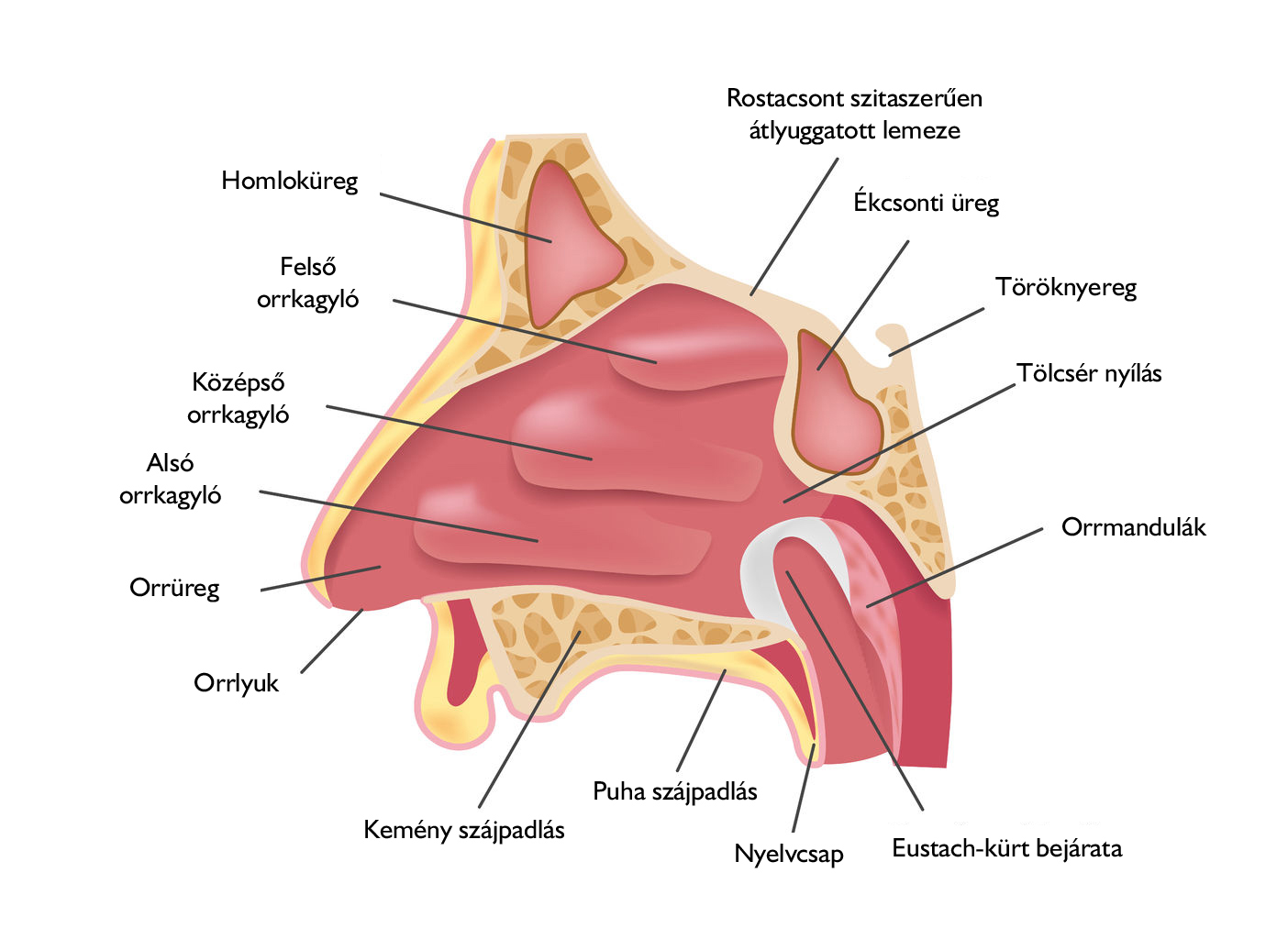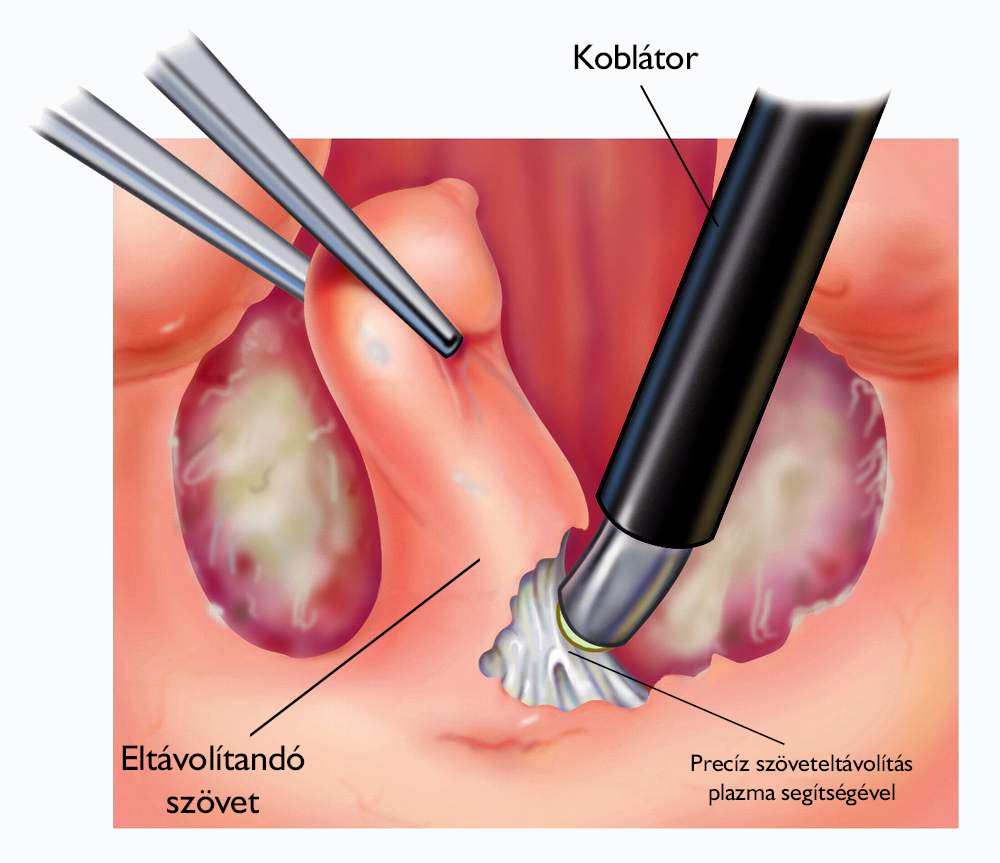Adenoidectomy
The nasal tonsil (adenoid) or nasopharyngeal tonsil is located in a hidden place at the back of the nasal cavity, at the top of the pharynx, right next to the openings in the auditory tube. The adenoid is part of the ring of lymph tissue (Waldeyer’s ring) in the oral cavity and pharynx (which includes the tonsils, the lingual tonsil, the lymph tissues in the pharyngeal and maxillofacial mucosa), which is an important factor in controlling infections, and it is the first immunological screening station of infections targeting the body.
When is adenoidectomy needed?

Abnormally enlarged adenoids can cause and maintain nasal respiratory distress, rhinolalia, snoring, sleeping with open mouth, stagnation of nasal discharge, and acute/chronic sinusitis by closing the nasopharynx. Closing the auditory tubes’ openings, it can lead to acute and chronic otitis media, temporary or permanent hearing loss. Stagnant and runny nasal discharge can lead to coughs, laryngitis, bronchitis, pneumonia, and it can worsen existing asthmatic symptoms.
A child whose adenoid is enlarged or inflamed, is often inattentive and sleep deprived, and their mouth is often open during the day, which is why their facial expression can typically be “dumb”. If the size of the adenoid reaches the size that produces the symptoms and diseases above, then the removal of the adenoid is the only option for children, from which a lasting result and healing can be expected. In adulthood, the nasal tonsil withers, and if it remains, its removal and histological examination is required.
In case of an enlarged adenoid, the following symptoms are observed:
- oral breathing, snoring, restless sleep, daytime fatigue
- eating problems
- permanent nasal congestion
- recurrent runny nose, sinusitis, cough (bronchitis)
- hearing loss (inattention might be a symptom in children), recurrent otitis media, earache
After adenoidectomy, the body is still able to fight infections as there is enough lymph tissue remaining in the oral cavity and pharynx (throat, lingual tonsil, etc.).
How does the procedure work?
The adenoid is removed orally with a special spoon-like device called an adenotome under nasal endoscopic examination, solely under anaesthesia. During surgery, the mouth is kept open with a metal mouth spreader that rests partly on the front teeth and partly on the tongue. During the removal of the adenoid, a haemostatic tampon is used for the duration of the operation, in case of heavier bleeding, the haemostasis is done with an electric device. The duration of the surgery is about 20-40 minutes. In our hospital, it is also possible to perform adenoidectomy on children over the age of 3.
Coblation adenoid surgery - modern technology, minimal tissue damage
In our hospital, there is also a possibility for modern, so-called coblation adenoidectomy. Modern technology combines radio frequency energy and saline to create a plasma field. With coblattion technology, the focused plasma allows precise removal of tissues at low temperatures, resulting in smoother anatomical surfaces and reducing the heat load on surrounding tissues compared to conventional monopolar diathermy devices or mechanical cutting tools.

The plasma technology procedure reduces the time of the operation, the pain after the operation is milder and the post-bleeding complications are less frequent.
Why is coblation adenoidectomy more effective than traditional surgery?
With the help of the coblation technology, the tissue is removed at a significantly lower temperature (40-70 Celsius) than the traditional method, on a molecular level, instead of burning or damaging the cells. The modern procedure allows precise removal of the targeted tissue with minimal damage to nearby, healthy tissues. During the electrosurgical procedure, a very high temperature (400-600 Celsius) is generated. This high thermal energy promotes tissue vaporization, which can also cause significant damage to surrounding, healthy tissues.
Advantages of coblation adenoidectomy:
- Mild pain compared to conventional surgery
- Shorter surgical time
- Minor bleeding during the procedure
- Faster return to normal eating habits and lifestyle
- Minimal tissue damage
What are the risks and advantages of adenoidectomy?
Risks
As with any surgical procedure, there are risks associated with adenoidectomy, primarily various infections and bleeding. It is important that in case of nosebleed, bloody spit, bloody or brownish-black vomit, a severe weakness, headache not responding to painkillers, high fever, immediate examination is required in our Hospital or the territorially competent otolaryngology department. In this case, call our case manager.
Before the operation, you will receive an information sheet and a statement of consent, which contains detailed information about the adenoidectomy, its risks, information before and after the procedure, and what to do. In all cases, it is possible to discuss the possible risks of surgery with your doctor before deciding on treatment.
There are also risk factors associated with anaesthesia, for which we provide a separate information sheet and a statement of consent. Mandatory preoperative examinations ensure that the risk is minimized.
Advantages
Removal of the adenoid reduces the frequency and severity of nasal and ear complaints. At the same time, it can prevent many serious diseases and hearing loss that affect the middle ear, which could otherwise only be remedied with major ear surgery.
Surgery, of course, also reduces the frequency of the use of antibiotics and other medications for infections that develop and often recur due to the enlargement of the adenoid.
Am I fit for adenoidectomy?
The first follow-up examination is performed one week after adenoidectomy, we monitor healing and rule out the likelihood of possible infection or bleeding. Depending on your condition, a second follow-up examination may be needed.
The need for adenoidectomy is decided and recommended based on your medical history, and an otolaryngologic examination (including nasal endoscopy) performed at Medicover Private Hospital. The suitability for anaesthetic surgery is decided by our anaesthesiologist, or, if necessary, internist, based on a blood count, ECG examination and chest X-ray.
How do I prepare for surgery?
- Bring your previous final reports for preoperative examination and consultations, make a list of your regular medications, vitamins, dietary supplements, other health problems, previous illnesses, drug sensitivities and allergies, and possible diet.
- You will find all the necessary information about the surgery in the surgical and anaesthetic patient information and consent form received in person or by e-mail before the operation, please read it, sign it, give it to the anaesthesiologist and bring it to the operation!
What should I do after adenoidectomy?
In the postoperative period, usually on the day of surgery, mild or more severe nosebleeds, bloody sputum, bloody vomit, cough stimuli, cough, and restlessness may occur in an anesthetized patient. In the days after surgery, weakness, drowsiness, dizziness, fever, headache, and nausea may occur due to varying amounts of blood loss, surgical stress, and medications used. After surgery, a blood clot in the nose, swelling of the nasal mucosa, can also cause nasal congestion.
After adenoidectomy, the pain is minimal, typical for 1-2 days after surgery and can be well treated with oral analgesics.
In the case of uncomplicated surgery, you can return home one day after the procedure. In the 2 weeks after the operation, a health-conscious lifestyle and rest are recommended, it is necessary to avoid activities that raise blood pressure and cause head bleeding, as these can cause post-bleeding. Do not blow your nose during this time. No dietary restriction is required, a lot of fluids should be consumed, alcohol consumption is not allowed.
In the case of uncomplicated recovery, you can return to your job after 14 days, the time of full recovery, the complaint-free state is approx. 3 weeks. Serious physical work, sports from the 4th week onwards are allowed.
We recommend that you do not travel to a place where there is no health facility nearby or travel by plane for two weeks after surgery. This is suggested because the possible post-bleeding must be treated within a relatively short period.
Why are regular follow-up examinations important after adenoidectomy?
The first follow-up examination is performed one week after adenoidectomy, we monitor healing and rule out the likelihood of possible infection or bleeding. Depending on your condition, a second follow-up may be needed.
Convenience services
We accommodate our clients in a modern, pleasant, air-conditioned single room. Each room has a private bathroom, fridge and TV, and free WIFI access. We also provide our clients with individual nurse supervision, who will help your continuous recovery during your stay.
